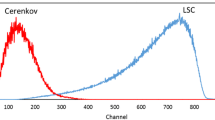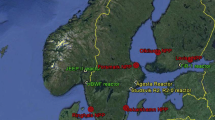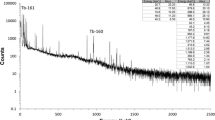Abstract
Early determination of 89Sr and 90Sr in radiological emergency is hampered by the presence of interfering short-lived fission products. In this study, three commonly used radioanalytical strategies for 89Sr and 90Sr were evaluated theoretically considering their suitability in a nuclear explosion scenario. The methods were evaluated with respect to the need for decay time of interfering short-lived strontium and yttrium isotopes, and reduction of other known interfering nuclides prior to measurement. The strategy shown to be most successful included initial separation of strontium and determination of 89Sr, followed by an yttrium separation and counting of 90Y. 89Sr and 90Sr could be determined about 5 and 9 days after a nuclear explosion, respectively.
Similar content being viewed by others
Avoid common mistakes on your manuscript.
Introduction
Radioactive strontium is produced with a high yield in the neutron induced fission of 235U and 239Pu, and has over the years been released to the environment, mainly from atmospheric nuclear explosions, nuclear waste discharges and from the Chernobyl accident [1]. Due to chemical behaviour similar to calcium, radioactive strontium will accumulate in bone.
In the case of a radiological emergency, e.g. nuclear power plant (NPP) accidents, fallout from nuclear detonations or radiological attacks [2], rapid determinations of 90Sr and 89Sr in different sample matrices should be done. Hence, with a half-life of 28.8 years, 90Sr is the strontium isotope which produces the highest dose to the population with time. However, in the short term 89Sr (t ½ = 50.5 days) shows activity levels 10–170 times higher than those of 90Sr depending on scenario. Hence, an early measurement of both isotopes will be required.
Both 89Sr and 90Sr (as well as 90Y) are pure β-emitters. Since β-radiation is not monoenergetic, spectral resolution of the individual nuclides is difficult and highly specific radiochemical separation is necessary prior to measurement. Commonly used analytical methods involve measurements of the emitted β-particle produced in the radioactive decay of the strontium isotopes and/or the 90Sr daughter nuclide 90Y. However, in fresh fallout from a nuclear detonation or an NPP accident, high activity of additional strontium and yttrium isotopes of relatively short half-lives are dispersed along with 89Sr and 90Sr. Those high energy β-emitters hinder the activity determination of 90Sr by traditional methods [3]. In addition, a number of other fission products, with chemical properties similar to those of strontium or yttrium, are suspected to cause interference problems, e.g. radionuclides of barium and the lanthanides.
In this work the influence of potentially interfering radionuclides in the determination of 89Sr and 90Sr in radiological emergency was studied. Furthermore, different methods were reviewed with respect to their performance in a radiological emergency, i.e. their capability to discriminate potential interferences to a level where the interferences will not cause a significant systematic bias in the measurement of 89Sr and 90Sr. Finally, a candidate method most suitable for measurement of both 89Sr and 90Sr in radiological emergency was presented. This candidate method was validated experimentally in a separate paper [4]. This work was focused on fall out from a nuclear explosion since this would present the most difficult case from a measurement point-of-view. The scenario involving malicious use of 90Sr would not suffer from interference from other short-lived radionuclides, and was not addressed in this paper.
Method
A theoretical model for the prediction of potential interfering radionuclides in measurement methods of 89Sr and 90Sr was developed. This model consisted of the following parts:
A source term
The source term was based on the isobaric fission product yields from the fast neutron fission of 235U. Data for the fission product yields were taken from England and Rider [5]. About 2 h after detonation the most short-lived radionuclides in each isobar have decayed, thus it is possible to use the cumulative and individual fission yield to estimate the relative activity. The model did not take activation products into consideration. However, beside the strontium and yttrium isotopes, barium and the lanthanides as potential interferences were included. These were selected on the basis of chemical similarities to the radionuclides measured, in combination with their individual yields in the instant fission of 235U.
The radioactive decay, and ingrowth, of relevant radionuclides
The calculated relative activities 2 h after detonation were normalised to the 90Sr activity, i.e. the relative activity of 90Sr at time t 0 = 2 h was set to unity. Furthermore, radionuclides having half-lives shorter than 1 h were not considered. Table 1 lists relevant isotopes of strontium and yttrium with half-lives and β-energies subtracted from ENSDF [6]. The decay and ingrowth of radionuclides in radioactive decay chains were solved by the Bateman equations [7].
Chemical separation(s)
Chemical separation(s) was/were included and could be applied at any time after an event. A chemical separation would not separate different strontium isotopes from each other, but separation of strontium from e.g. barium due to different affinities for a separation agent is possible. This is also valid for yttrium and the lanthanides. Target decontamination factors for a barium/strontium- and a lanthanum/yttrium-separation were used. Both decontamination factors were assigned the value of 0.01, i.e. 1% of the barium remained in the strontium fraction after the strontium separation and 1% lanthanum remained in the yttrium fraction after the yttrium separation. Chemical yields in separations were assumed to be quantitative.
Measurement
The measurement techniques simulated in this model is Cerenkov or LSC counting. When Cerenkov counting was used, a threshold energy of 0.6 MeV was set for the detection of β-particles. Differences in counting efficiency were not taken into account, i.e. all β-particles were assigned the same counting efficiency.
The assessment included different analytical strategies for the determination of 89Sr and 90Sr. In general, these strategies could be divided into three sub-groups:
-
1.
Methods based on a single strontium separation. The separation system studied was the strontium specific separation material Sr-resin (Eichrom, Lisle, IL, USA), which contains a crown ether (bis-t-Butyl-cis-Dicyclohexano-18-Crown-6) as separation agent. The counting approach considered in this work was Cerenkov counting of 89Sr in combination with liquid scintillation counting of 89Sr + 90Sr directly after the chemical separation [8]. Another approach based on LSC measurement of the Sr-fraction and spectrum deconvolution has been presented previously, but was not used in this study [9].
-
2.
Methods based on a first separation of yttrium where the yttrium fraction is discarded, ingrowth of 90Y followed by a second yttrium separation. Here the separation system studied was HDEHP, di(2-ethylhexyl)-phosphoric acid, which for example is the active complexing agent in Ln-resin (Eichrom, Lisle, IL, USA). The method often used for measuring 90Y in the determination of 90Sr is Cerenkov counting [10], which also was considered in this work.
-
3.
A strontium separation followed by an yttrium separation after an ingrowth time of 90Y, e.g. a combination of Sr-resin and Ln-resin. In this method, both 89Sr and 90Sr (via 90Y) can e.g. be measured using Cerenkov counting. An alternative approach consisted in performing a Sr-separation, followed by ingrowth of 90Y, a second Sr-separation and counting of the remaining sample containing 90Y. Both alternatives were considered in this work.
A maximum bias in the measurement due to interfering radionuclides was set to 5%, i.e. the activities of the interfering radionuclides should be less than 5% of the activity of the measured analyte. From Heilgeist [9] and Ikäheimonen and Vartti [8] it can be concluded that a maximum 89Sr/90Sr activity ratio of about 10 would be possible for a non-biased measurement of 90Sr. Therefore a highest activity ratio of 10 was chosen as a criterion for an interference-free measurement of 90Sr due to the presence of 89Sr when a single strontium separation is used.
Results and discussion
Measurement of 89Sr and 90Sr shortly after a nuclear event is a challenging task due to short-lived radionuclides present in a much higher activity compared to the activities of 89Sr and 90Sr. Figure 1 shows the relative activities as a function of time for the relevant radionuclides, i.e. 89Sr, 90Sr, 90Y, and the identified possible interfering species after instant fission of 235U.
As seen in the figure, many fission products were present at activity levels orders of magnitude higher than 89Sr and 90Sr. Even 2 weeks after an event, the activity of 90Sr remained three orders of magnitude below that of other fission products.
Methods based on single strontium separation
Figure 2 shows that the high 91Sr activity would interfere in the measurement of 90Sr. Within the first days after an event, 91Y, 92Y (and 90Y) will grow up in the strontium fraction. After about 5 days the activity of 91Sr is less than 5% of the activity of 89Sr. Regarding the lanthanides, these would not follow strontium but be rinsed out within a few free column volumes [11]. The remaining interference is between 90Sr and 140Ba and its daughter 140La. According to Horwitz et al. [11] it should be possible to reduce barium in a strontium separation using Sr-resin, but only after excessive rinsing. The conclusion is then that about 5 days after a nuclear explosion, a measurement of 89Sr solely is possible, cf. Fig. 2. The ingrowth of 90Y in the strontium fraction would not cause any problem due to the high 89Sr/90Sr activity ratio.
Regarding measurement of 90Sr, the limitation is the high activity ratio 89Sr/90Sr in a fall out from a nuclear explosion. The criterion for this ratio was set to 10 according to Ikäheimonen and Vartti [8], which takes 7 months to achieve after a nuclear explosion. It would then be possible to measure 89Sr shortly after a nuclear explosion (about 5 days), but reliable results for 90Sr would take several months to achieve.
Methods based on yttrium separation
It should first of all be concluded that methods based on separation of yttrium, e.g. using separation agents and chemical conditions appropriate for tri-valent ions, would not be able to provide information about the activity of 89Sr.
Beside the short-lived isotopes of yttrium the main interference would be 140Ba/140La. However, barium will not be extracted in an yttrium separation using e.g. Ln-resin but lanthanum would, at least to some degree [12]. 140La will therefore grow in from 140Ba and be extracted in the second separation together with 90Y that has been produced from the decay of 90Sr. Not until 140Ba has decayed to a level where 140La not would interfere, a reliable result for 90Sr would be possible to get, which will take about 3 months (Fig. 3).
Relative activities of radionuclides present in the eluate after a first separation of yttrium 90 days after an event using e.g. Ln-resin (Eichrom, Darien, IL, USA). After 14 days a second yttrium separation is done (although it would be possible to achieve a reliable result for 90Sr after an ingrowth time of 24 h in this case)
Methods based on a strontium separation followed by an yttrium separation
First, this method is equivalent to a method based on strontium separation regarding measurement of only 89Sr, i.e. reliable results for 89Sr would be possible after about 5 days. However, the reason to assess this method is to investigate how soon after a nuclear event it would be possible to achieve results for both 89Sr and 90Sr. Considering radioactive isotopes of strontium and yttrium, an early measurement is hampered due to the presence of 91Sr/91Y. The strontium separation has to be done at a time where the activity of 91Sr has decayed to a level where the activity from the ingrowth of its daughter 91Y not will exceed 5% of the activity of 90Y, which is measured in the 90Sr determination. However, due to the longer half-life of 91Y relative to 90Y, the activity ratio of 91Y/90Y will increase with time in the yttrium fraction. The consequence of this is that if the measured radionuclide in the 90Y measurement has to be verified by evaluation of the half-life, the contribution from 91Y to the measured signal may be significant with time. The solution to this is to wait longer before the strontium separation is done. However, the main limitation with this method comes, as for the other methods, from 140Ba/140La.
A substantial removal of 140Ba in the strontium separation will limit the presence of 140La ending up in the yttrium fraction after the yttrium separation. Thus, an appropriate combination of the times when the separations are done and the chemical conditions, will make a 90Sr measurement (via 90Y) possible if the strontium separation is done after about 8 days followed by an ingrowth time of 90Y and an yttrium separation on day 9. This is shown in Fig. 4. Note that this method is based on a strontium separation followed by an yttrium separation based on a complexing agent specific for tri-valent ions. An alternative would be to use Sr-resin in the second separation. However, such a method approach would not work before about 40 days after the event since too much 140Ba would remain in the solution together with 90Sr/90Y. Hence, the interference of 140La would not be resolved.
This work has focused on the possibility to measure 89Sr and 90Sr in a fall out shortly after a nuclear explosion. Other authors [8, 9] have reported methods capable for the determination of both 89Sr and 90Sr in activity ratios less than about 10. However, after a nuclear explosion the activity ratio will be much higher, about 170, decreasing to about 150 one week after the explosion. These methods will therefore not work shortly after a nuclear explosion. Moreover, the 89Sr/90Sr activity ratio shortly after the Chernobyl accident ranged between 10 and 20 [13, 14]. It may therefore be concluded that some methods expected to work after a nuclear power plant accident will not produce reliable results.
Other tasks for a radiation preparedness organisation may be of higher importance directly after the fall out. However, it is interesting to note that appropriate results for 90Sr would not be possible to achieve, using standard methods based on e.g. Sr-resin for environmental control of 90Sr, until several months after an event. Finally it should be mentioned that in a scenario of a nuclear reactor accident, the time when appropriate results would be possible to achieve is reduced as compared to the nuclear explosion scenario.
Conclusions
In this work methods for the determination of 89Sr and 90Sr shortly after a nuclear event were assessed using a theoretical measurement model. Furthermore, different methods were reviewed with respect to their capability of resulting in un-biased results shortly after a nuclear explosion. It was inferred that a single strontium separation would give a satisfactory result with respect to 89Sr within 5 days. However, by using such a method, a relevant result for 90Sr would not be possible earlier than about 7 months after the event. Moreover, the study showed that the method-of-choice would consist of a strontium separation and measurement of 89Sr after about 8 days, followed by an ingrowth time of 90Y, and thereafter an yttrium separation after additionally one day, if results of both 89Sr and 90Sr are desired.
References
Eisenbud M, Gesell T (1977) Environmental radioactivity, 4th edn. Academic Press, San Diego
Valentine J (2005) Protecting people against radiation exposure in the event of a radiological attack (ICRP96), Ann ICRP 35(1):III–IV
Nygren U (1999) Determination of radioactive strontium during preparedness exercise Lotta, FOA-R-99-01045-861-SE, FOI NBC Defence, Umeå
Tovedal A, Nygren U, Lagerkvist P, Vesterlund A, Ramebäck H (2009) J Radioanal Nucl Chem. doi:10.1007/s10967-009-0179-3
England TR, Rider BF (1994) Evaluation and compilation of fission product yields, LA-UR-94-3160, Los Alamos National Laboratory, Los Alamos. http://ie.lbl.gov/fission.html
Evaluated Nuclear Structure Data File (ENSDF) (2006) National Nuclear Data Center (NNDC), Brookhaven National Laboratory, 9 June 2006. http://www.nndc.bnl.gov/ensdf/index.jsp
Bateman H (1910) Proc Camb Philos Soc 16:423
Ikäheimonen TK, Vartti VP (1997) A method for analysing and measuring 89Sr and 90Sr activities from environmental samples in an emergency. In: Proceeding from “Rapid radioactivity measurements in emergency and routine situations”. NPL, Teddington, UK, Oct 1997
Heilgeist M (2000) J Radioanal Nucl Chem 245:249–254
Francois B (1973) Int J Nucl Med Biol 1:1–14
Horwitz EP, Dietz ML, Chiarizia R (1992) J Radioanal Nucl Chem 161:575–583
Ahlstad J, Augustson JH, Danielson T, Farbu L (1974) A comparative study of the rare earth elements in extraction by HDEHP/ShellSOL T from nitric acid and sulphuric acid solutions. In: ISEC 74 proceedings, pp 1083–1103
Saxén R, Taipale TK, Aaltonen H (1987) Radioactivity of wet and dry deposition and soil in Finland after the Chernobyl accident in 1986. STUK-A57. Finnish Centre for Radiation and Nuclear Safety, Finland
UNSCEAR (2000) Ionizing radiation: sources and biological effects. UNSCEAR report 2000
Acknowledgement
The Swedish Radiation Safety Authority, SSM, is gratefully acknowledged for funding this work.
Author information
Authors and Affiliations
Corresponding author
Rights and permissions
About this article
Cite this article
Tovedal, A., Nygren, U. & Ramebäck, H. Methodology for determination of 89Sr and 90Sr in radiological emergency: I. Scenario dependent evaluation of potentially interfering radionuclides. J Radioanal Nucl Chem 282, 455–459 (2009). https://doi.org/10.1007/s10967-009-0177-5
Received:
Accepted:
Published:
Issue Date:
DOI: https://doi.org/10.1007/s10967-009-0177-5








